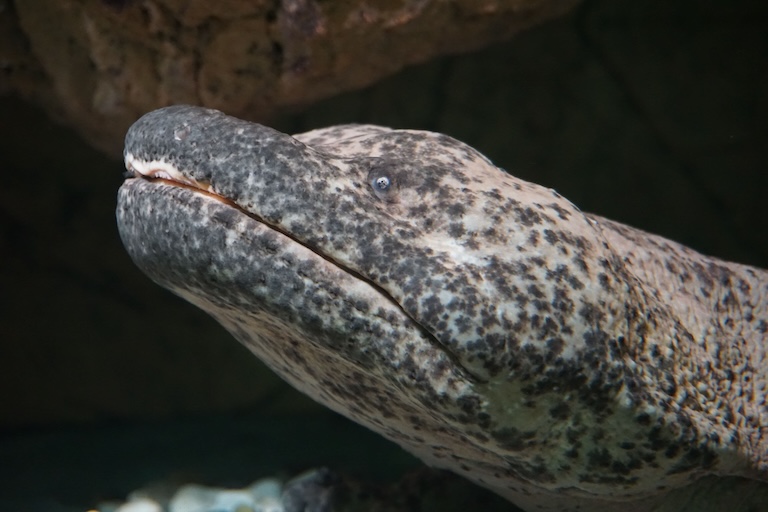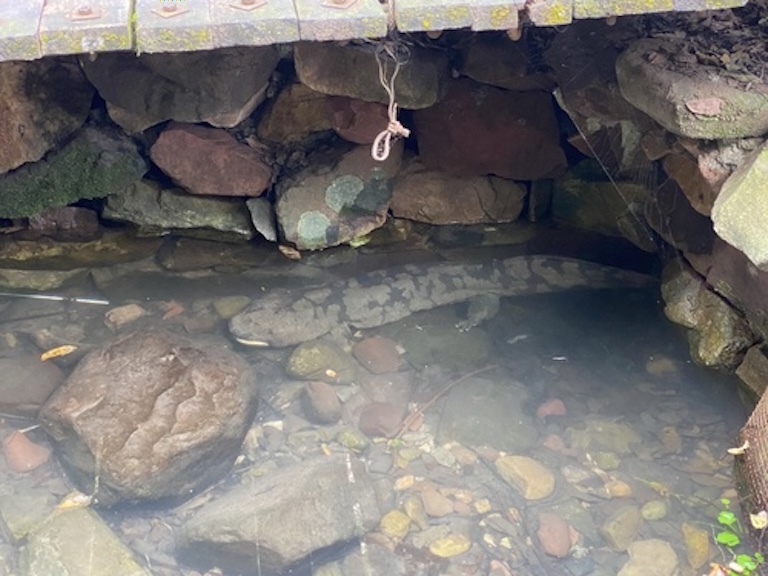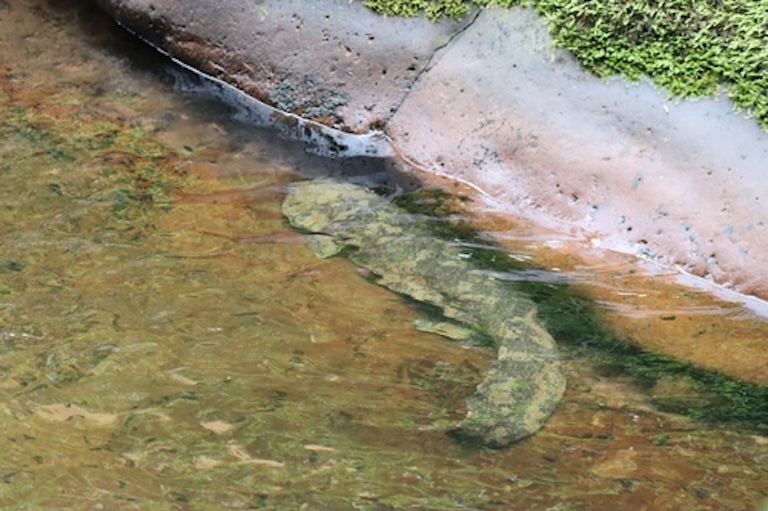Chinese Giant Salamander Profile
Everyone except the most affected fundamentalist reality-deniers knows about the dinosaurs. They were massive reptiles who dominated the land for almost 200 million years and then got smashed by a big rock and gave way to the rise of mammals. Fine.
But fewer people know that before the dinosaurs took over, and before even reptiles had even been invented, amphibians were boss.
Indeed, reptiles evolved from a bunch of swamp-living, predatory (sort of) amphibians called Labyrinthodonts, and they did that about 320 million years ago, so we’re talking way back.
But for the 200 million years or so prior to this, these amphibians were the top predators and filled many of the damp niches that would later be filled by reptiles and mammals.
Today, amphibians are mostly limited to croaking little things next to ponds, but there are a few that carry the torch from their monstrous, dominating ancestors, and the Chinese giant salamander, the largest extant amphibian, is a perfect example of this.

Chinse Giant Salamander Facts Overview
| Habitat: | Rocky mountain streams and lakes, clear, cool waters |
| Location: | Yangtze River basin, introduced to Japan |
| Lifespan: | 60+ years in captivity, possibly even longer in the wild |
| Size: | Up to 1.8 metres (6 ft) long |
| Weight: | Can reach more than 12 kg (26.5 lb) |
| Colour: | Marbled; can be dark brown, green, or black in colour |
| Diet: | Invertebrates, amphibians, fish and small mammals |
| Predators: | Otters, foxes, weasels, and badgers |
| Top Speed: | Slow |
| No. of Species: | 1 |
| Conservation Status: | Critically Endangered |
Chinese giant salamanders are enormous by modern standards and have remained more or less that way for over 170 million years, since the middle of the Jurassic period.
These prehistoric beasts give us a clue about what life in the swamps of the Carboniferous might have looked like, and are top aquatic predators, relying on stealth and powerful snapping jaws to dispatch their victims.
Sadly, despite being able to complain about it, and having survived two mass extinction events, these amphibious monsters are almost extinct due to the very human habit of killing them all and some efforts to address this have created even more problems!
Interesting Chinse Giant Salamander Facts
1. They’re ancient
This family of salamanders has been around for a seriously long time and is often referred to as “living fossils”, on account of their kind being more or less unchanged for around 170 million years.
Around that time, various beasts like the Apatosaurs and Stegosaurs roamed the Earth, and T-Rex wouldn’t show up for nearly 100 million years.
This family has only five other species left in it, and all are smaller than this one, making it the largest salamander – and the largest amphibian – in the world.

2. They’re huge
This species, and the family as a whole, are entirely aquatic salamanders, but they do grow lungs as they mature, so they are able to breathe out of the water.
The Chinese giant salamander averages over a metre in length and has been found to reach 1.8 metres in the past, suggesting that before they became so rare, they likely got much larger.
One key piece of evidence to back this up is that they don’t appear to stop growing until they die of old age. And they can live for a long time! 1
3. They exhibit indeterminate growth
Nobody knows how long this species can live, as they are pretty much always killed before they can die of old age. Some specimens in captivity lasted around 60 years or so, but it’s not clear how old they were when they were caught.
Other similar species, like the slightly smaller Japanese giant salamander, are said to have a maximum recorded lifespan of around 72 years, so it’s reasonable to assume that this one is similar.
Most of the animals we’re familiar with exhibit what’s known as determinate growth – that is, they grow rapidly as kids and then slow to a halt when they reach maturity (not counting the increasing girth as we age).
Some animals and this giant salamander is one, grow pretty much non-stop. They will grow faster as juveniles, but instead of stopping, they just slow down and will get bigger and bigger indefinitely.
This is known as indeterminate growth, and it means that given perfect conditions, this species could become a real monster.
Regardless, they are already pretty fearsome, not least for their habit of eating one another.
4. They’re cannibals
Cannibalism is one of those features that really feel prehistoric. We like to think we’ve come a long way from the time when we’d consider one another in a gustatorial context, but certain plane crashes and errant mountain hikes have suggested that all it takes is a lack of access to alternatives.
The giant salamanders never bothered with this pretence, and readily chug conspecifics if they can get their mouths around one.
In fact, one study found that over a quarter of the mass of food inside the belly of these salamanders is made up of other members of their species.
Like many salamanders of their kind, this one has terrible vision and seemingly zero conscience and will rely purely on vibrations in the water to sense prey.
Then, they’ll move towards it slowly, stalking it blindly, until close enough to strike. The mouth opens rapidly, causing an area of low pressure, into which the water around the victim – and the victim inside it – are sucked.
5. They lay a lot of eggs
Female giant salamanders have to compensate for this additional threat by laying plenty of eggs. Around 600 eggs can be laid in a single clutch, each less than a centimetre across.
Then, the males, or so-called “den masters” will guard them until they hatch a couple of months later. 2

6. They can cry
It’s often said that if animals could scream like people, we’d treat them with a lot more respect.
That idea comes into question with the footage of a terrified giant salamander screaming like a young girl and being held up for crowds of gawping onlookers to take photos.
It seems like this lack of concern for animals, in general, will soon spell the end of the ancient salamanders – having survived two mass extinction events and six seasons of Lost, human greed looks to be the first insurmountable challenge for the species. 3
7. They’re in so much trouble
Amphibians are very susceptible to pollution in water, and these ones are no exception. Unfortunately, pollution in water has become the new normal, and so viable habitats are shrinking rapidly for the salamander.
But what’s worse is the human desire to hunt everything edible until they’re all gone, and this is the major threat to the species, and what has rapidly sent it to Critically Endangered status.
To this day, giant salamanders can be found slowly dying in Chinese wet markets, to be sold as food for as little as $50.
This is despite the fact the species is listed as Appendix 1 of CITES, the highest protected rank in the Convention on International Trade in Endangered Species.
To make matters worse, some efforts to protect the animals have simply created new problems. 4
8. They have become invasive
Well-intentioned efforts to protect the salamanders saw them introduced into alien habitats and accidentally hybridised with other subspecies and even the Japanese species.
Now, the genetic makeup of populations of this species is all over the place, and in some locations they have even become invasive, wreaking havoc on their new ecosystems.
Chinese Giant Salamander Fact-File Summary
Scientific Classification
| Kingdom: | Animalia |
| Phylum: | Chordata |
| Class: | Amphibia |
| Order: | Urodela |
| Family: | Cryptobranchidae |
| Genus: | Andrias |
| Species: | davidianus |
Fact Sources & References
- Lauren Hatch, “Andrias davidianus”, Animal Diversity Web.
- “The Chinese giant salamander”, Chinese Giant Salamanders.
- Razanah Abd (2019), “fish can cry like a baby girl”, YouTube.
- “Chinese Giant Salamander”, IUCN Red List.
